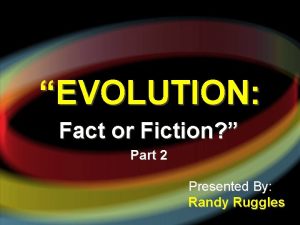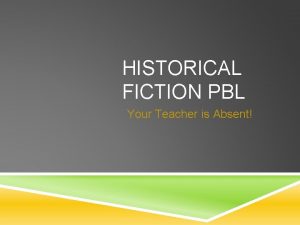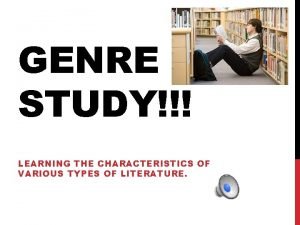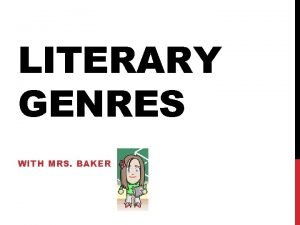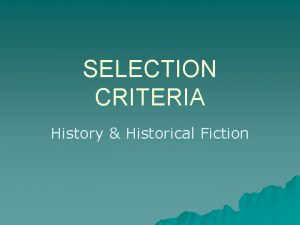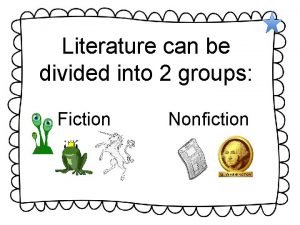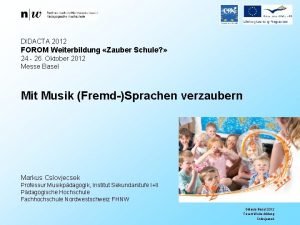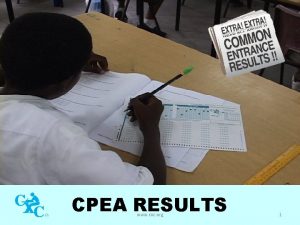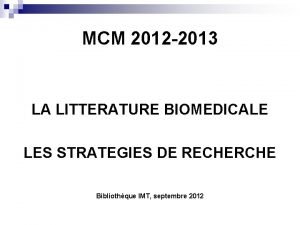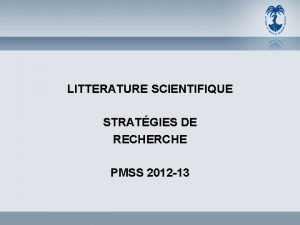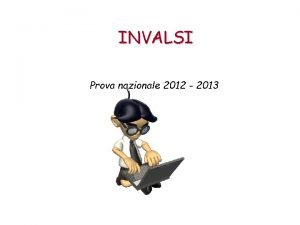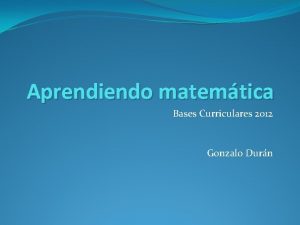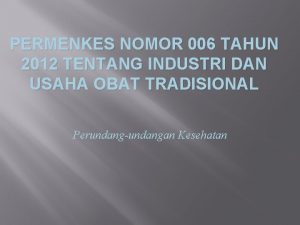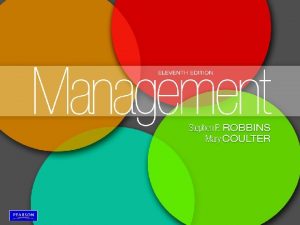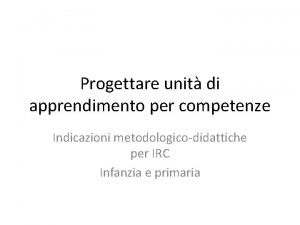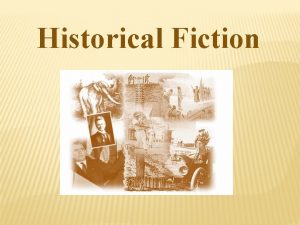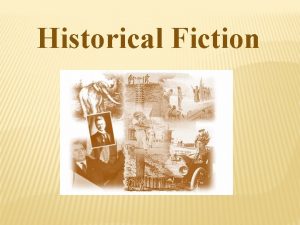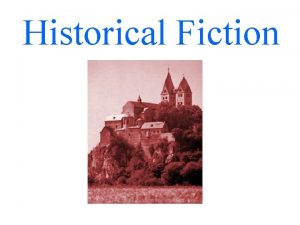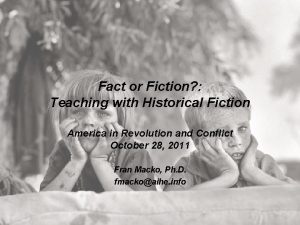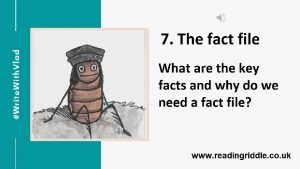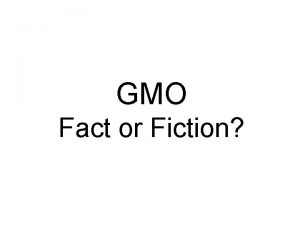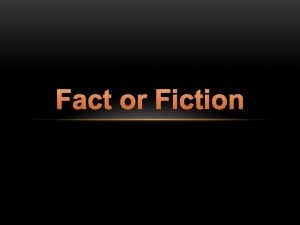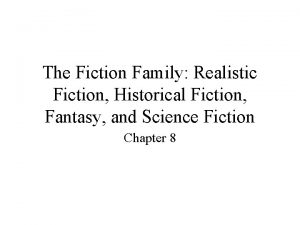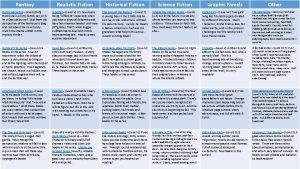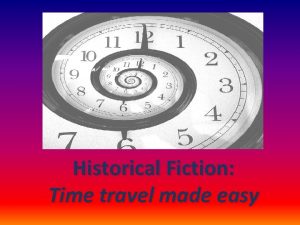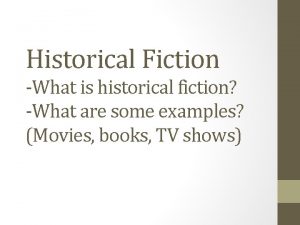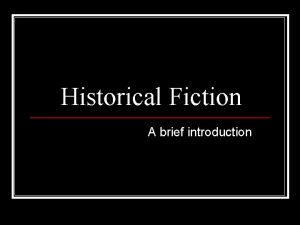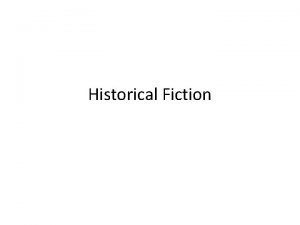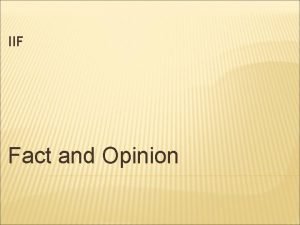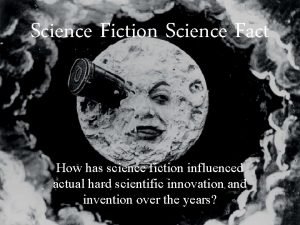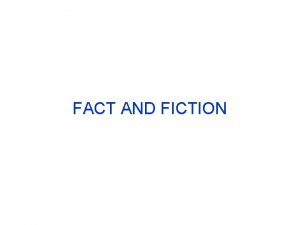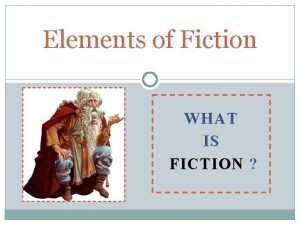Fact or Fiction Teaching with Historical Fiction 2012




























- Slides: 28

Fact or Fiction Teaching with Historical Fiction © 2012 CICERO Systems™

Historical Fiction and the Common Core O Level of Examination O Compare and Contrast O Common Core Learning Framework O Key Ideas and Details O Assessing the reliability of the information O Comparing ideas within and across texts © 2012 CICERO Systems™ 2

Framing the Session O What is historical truth? O What strategies promote students’ understanding of historical truth? O How does historical fiction contribute to an understanding of historical truth? © 2012 CICERO Systems™ 3

What is historical truth? O For historians, truth is a complex concept. O The idea that history deals with true events and fiction with invented ones isn’t always helpful. O To support students in understanding what is “true” in history, they need to understand that historical fiction combines the three different kinds of truth: literal truth, artistic truth and historical trueness. O This process supports students in becoming critical readers/viewers of history and better historical thinkers. © 2012 CICERO Systems™ 4

What is literal truth? O Literal truth is an account that can be verified, such as an event that actually occurred at a certain time. O The Declaration of Independence was officially approved by the delegates on July 4, 1776. © 2012 CICERO Systems™ 5

What is artistic truth? O Artistic truth is an account that can’t be verified, but seems true based on what we know about human nature. O A young boy describes how happy he felt during the first celebration of the Declaration of Independence, as he watched people ringing bells, marching in a parade and hoisting the flag. © 2012 CICERO Systems™ 6

What is historical trueness? O Historical trueness is an account that cannot be verified, but is likely to have happened based on what we know about the historical context. It is plausible. O A soldier overhears George Washington say that the Declaration of Independence is one of the greatest documents ever written. © 2012 CICERO Systems™ 7

Why teach historical fiction? O Historical fiction: O Engages student interest. O Levels the playing field. O Provides details of daily O O life. Focuses on individuals over events. Presents the complexity of issues. Provide multiple perspectives. Bridges the gap between narrative and informational text © 2012 CICERO Systems™ 8

What are the features of quality historical fiction? O Quality historical fiction should: O Present a well-told story O O O © 2012 CICERO Systems™ that doesn’t conflict with historical records. Portray characters realistically. Present authentic settings. Artfully fold in historical facts. Provide accurate information through illustrations. Avoid stereotypes and myths. 9

What are the challenges of teaching historical fiction? O Historical fiction provides limited access to the broad range of historical interpretation. O Many examples of historical fiction present the dominant interpretation of history or that which is found in most textbooks. O This interpretation, or selective tradition, often excludes the voices of minorities, and as a result, limits student access to the truth. © 2012 CICERO Systems™ 10

O Historical fiction is often “presentist”. O The authors give the characters presentday thoughts, beliefs and concerns, thereby presenting an inaccurate view of the past. © 2012 CICERO Systems™ 11

O Historical fiction often contains historical inaccuracies. O Historical fiction reflects the historical context, the author’s purpose, and ideological predisposition. O The prevailing cultural attitudes of the time in which the novel is written may influence the author’s attitude toward the events. © 2012 CICERO Systems™ 12

O To effectively use historical fiction to support students in understanding history, they need to: O understand the three types of truth. O understand what historical fiction is and what they can expect to learn from reading it. O know that historical fiction and non-fiction present history in different ways. O question what they read. © 2012 CICERO Systems™ 13

What are the goals of the historian? O The goals of history: O Separate fact from myth O Make educated guesses using cultural clues O Consider multiple points of view O To achieve these goals, the historian: O Identifies and analyzes primary sources © 2012 CICERO Systems™ 14

What are the goals of the author of fiction? O The goals of fiction: O Entertain the reader O Create an emotional Connection O Convey a message or objective O Create memorable characters and plot O To achieve these goals, a writer often uses: O Poetic license O Invented dialogue and language © 2012 CICERO Systems™ 15

What are the guiding questions for reading historical fiction? O Guiding questions for reading historical fiction include: O Could the events described have happened? What evidence do I have? O Which characters really existed? What evidence do I have? O What are the examples of literal truth, artistic truth and historical trueness? O How does this book help me understand life in the past? © 2012 CICERO Systems™ 16

Featured Strategy Pairing Texts O Pairing historical fiction with non-fiction on the same event allows students to experience three kinds of historical truth: literal, artistic and contextual or historical trueness. O In this strategy, students read historical fiction to savor the story, and to identify examples of literal truth, artistic truth and historical trueness. O As they read, they sort the information into three categories: fact (literal truth), fiction (artistic truth), and not sure. © 2012 CICERO Systems™ 17

O After compiling their lists, students work in pairs or small groups to discuss and verify, where possible, the information on their fact, fiction and not sure lists. O As a class, they share and discuss their lists for further verification of the information on the fact and fiction lists. Here they also differentiate between artistic truth and historical trueness. O Finally, they compile a class list of questions based on the items on the not sure list. © 2012 CICERO Systems™ 18

O Using the class list, students read the paired non-fiction text and clarify the information on their not sure lists, marking the facts with a check. O Questions that are not answered as a result of reading the non-fiction text can be the basis of additional research. © 2012 CICERO Systems™ 19

Modeling the Strategy © 2012 CICERO Systems™ 20

Paired Texts The Civil War O My Brother’s Keeper: Virginia’s Civil War Diary by Mary Pope Osborne © 2012 CICERO Systems™ O The History of US by Joy Hakim vol. 6 21

Step #1 Compile the Lists O Form groups of 2 -4. O Read the excerpt from My Brother’s Keeper: Virginia’s Civil War Diary O Make three lists based on your knowledge of the Civil War: O What is factual O What is fiction O What you are unsure of © 2012 CICERO Systems™ 22

Step #2 Comparison and Discussion O Share and discuss the items on your lists with your group. O Come to consensus on what is fact, what is fiction and what remains uncertain. O Create research questions based on your list of unsure items. © 2012 CICERO Systems™ 23

Step #3 Class Discussion/Sort/Clarify O What did your group identify as: O Fact O Fiction O Unsure O What is your list of research questions? O Where might you find the answers to these questions? O How can historical fiction and non-fiction texts be paired in the classroom? © 2012 CICERO Systems™ 24

Additional Titles O Fiction O Behind the Blue and the Gray- The Soldier’s Life in the Civil War by Delia Ray O The Boys’ War. Confederate and Union Soldiers Talk About the Civil War by Jim Murphy © 2012 CICERO Systems™ 25

Resources from Cicero O Videos: O “The Civil War 1861 - 1863” O The Civil War 18631865” © 2012 CICERO Systems™ 26

Applying Paired Texts to the Classroom O Where and how could you use historical fiction in your classroom? O What adaptations could you make to the strategy of paired texts? O How might you use video and film? © 2012 CICERO Systems™ 27

Final Thoughts O High quality historical fiction: O Engages student interest O Levels the playing field O Provides details of daily O O life Focuses on individuals over events Presents the complexity of issues Provide multiple perspectives Bridges the gap between narrative and information text © 2012 CICERO Systems™ 28
 Contemporary realism literature
Contemporary realism literature Evolution fact fiction or opinion
Evolution fact fiction or opinion Characteristics of historical fiction
Characteristics of historical fiction Science fiction characteristics
Science fiction characteristics Facts about historical fiction
Facts about historical fiction Historical fiction subgenres
Historical fiction subgenres Historical fiction defintion
Historical fiction defintion Elements of narrative nonfiction
Elements of narrative nonfiction Realistic fiction
Realistic fiction Science fiction is a genre of speculative fiction dealing
Science fiction is a genre of speculative fiction dealing Micro teaching definition
Micro teaching definition Zauber schule
Zauber schule Infrastructure summit gartner
Infrastructure summit gartner Daya zhang
Daya zhang Email archiving and retention exchange 2012
Email archiving and retention exchange 2012 Windows server 2012 essentials launchpad download
Windows server 2012 essentials launchpad download Cpea results 2012 grenada
Cpea results 2012 grenada Mcm 2012
Mcm 2012 Distributor company profile sample
Distributor company profile sample Ydelsesbeskrivelse byggeri
Ydelsesbeskrivelse byggeri Pmss 2012
Pmss 2012 Work health and safety regulations 2012 sa
Work health and safety regulations 2012 sa Disegna nel piano quadrettato un rettangolo
Disegna nel piano quadrettato un rettangolo Decreto nº7.830/2012
Decreto nº7.830/2012 Bases curriculares 2012
Bases curriculares 2012 Aki kdigo 2012
Aki kdigo 2012 Permenkes no 006 tahun 2012
Permenkes no 006 tahun 2012 2012 pearson education inc
2012 pearson education inc Indicazioni nazionali 2012 mappa concettuale
Indicazioni nazionali 2012 mappa concettuale

